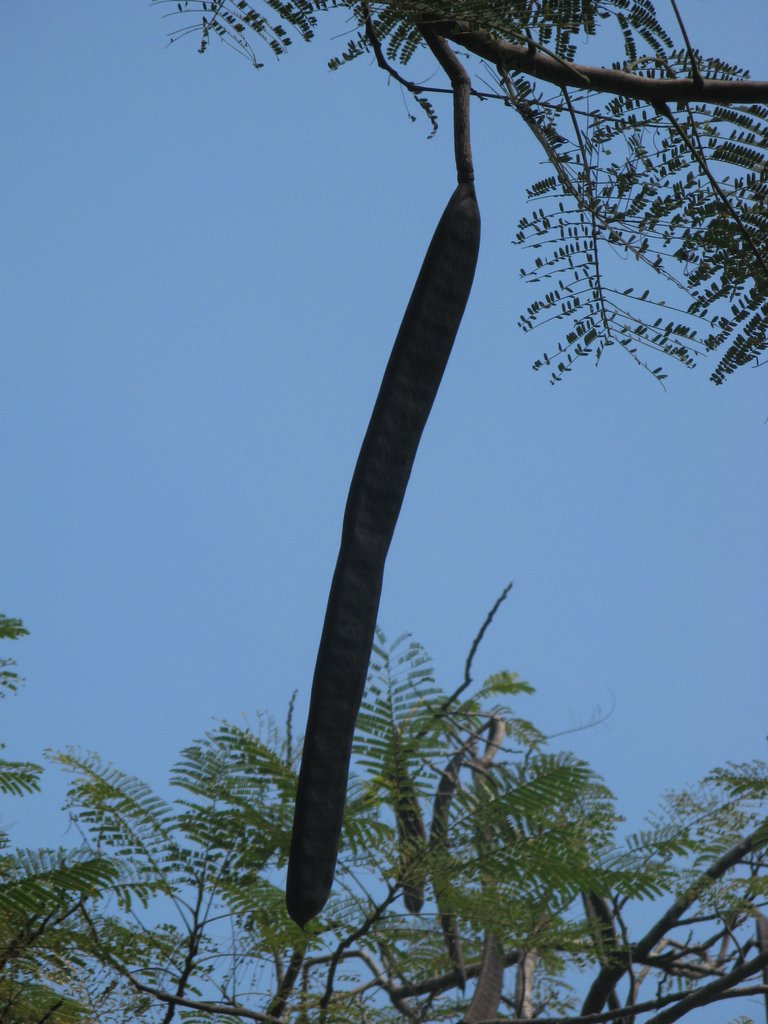A visit to the flame of the forest

Even though this will not be my first time seeing the flame of the forest, as the plant is commonly known, I have never been this close to it during its flowering season to savor its beauty.
For those that are not familiar with the common name, the plant's scientific name is Delonix regia. It belongs to the legume (Fabaceae) family, more specifically in the Caesalpinaceae sub-family.
A closer look at the bole
Before deciding to attend to the primary purpose of my visit, I took a few closer steps to the ornamental plant just to make some physical observations. The first thing I noticed is the structure of its bole, that is, the stem.

The bole appeared short and the trunk looked heavily anchored with numerous buttress roots. The root ensures that the tree is not easily uprooted by the characteristic wind that could be a feature of the tropical climate.
The bark of the bole looked brownish grey, kind of smooth with some obvious epidermic exfoliation. On the other side of the bole, a large opening filled with some kind of plaques can be seen. I kept wondering what could cause it or it serves some specific functions.

A bit higher up the bole and I discovered that the tree is harboring a tenant. An epiphytic Ficus species occupied the trunk of the bole. The epiphyte does no damage to the host in whatsoever way. All it needs is just a bit of space to hand its neck. Such a benign tenant, unlike parasitic tenants.

The leaves
The leaves of the flame of the forest looked kind of complicated unlike the leaves of most plants. The main leaf axis branched into several smaller axis with the latter having tiny leaf-like appendages, otherwise known as leaflets. This kind of leaf arrangement is known as a compound leaf.

The inflorescence
The most beautiful part of the flame of the forest that makes such a well sought-after ornamental plant is the red-themed flower. The flowers occur in a group or cluster known as racemose, with the young (sometimes yet to open buds) flowers at the center and older flowers growing around them. They usually occur at the terminal or axillary portion of branches.

Individually, the flowers are considered to be complete with all the necessary flora parts present.
Each flower consists of five brightly colored petals that primarily serve for the attraction of insect pollinators. Out of the five petals, one appeared to be variegated with white color. This is usually the case with the flowers of all the species of plants in the Caesalpinaceae sub-family. That is, they usually have one petal that looks distinct from the rest.

The calyx of the flower also amounts to five. It is hence safe to conclude that the flowers of Delonix regia are pentamerous, that is, the floral parts occur in groups of five.

Unfortunately, I could not get an original image of the fruits of Delonix regia. However, a copyright-free image of it is dropped below.

Apart from being ornamental, the plant also serves a wide variety of purposes to the locals. Several scientific journals have been published to elucidate the medicinal potentials of the plant.
Thank you all for reading.
Thanks for your contribution to the STEMsocial community. Feel free to join us on discord to get to know the rest of us!
Please consider supporting our funding proposal, approving our witness (@stem.witness) or delegating to the @steemstem account (for some ROI).
Please consider using the STEMsocial app app and including @steemstem as a beneficiary to get a stronger support.
That's a beautiful fire tree. Be careful out there and avoid getting caught by the virus and by the authority.
Indeed. I'm being very careful. Thanks
What a great journey! We all need this kind of visits more or less especially during this period. Stay safe and blessed!
Thank you. I sincerely appreciate your support! Stay safe and blessed too
How could you stepped out, i will surely report you to the authority(Am actually joking). The tree reminds me of my high school days. The red coloured petals use to attract us then. I think the fruit is has hard back and it normally make some funny sound when shaken. This is a nice write up @gentleshaid.
I didn't break any rule ::). Yes, that's the plant. I think they use to cal it "eko ọmọdé" back then.
Yeah eko omode back then.
It really looks like agmoore's profile pic. Is it the same tree species @agmoore ?
You are quite observant. It does looks like it but I can't say that with certainty until I can get a closer look at the image.
Hi @mathowl,
I got my picture from wikimedia commons. It's a Pōhutukawa tree, native to New Zealand.